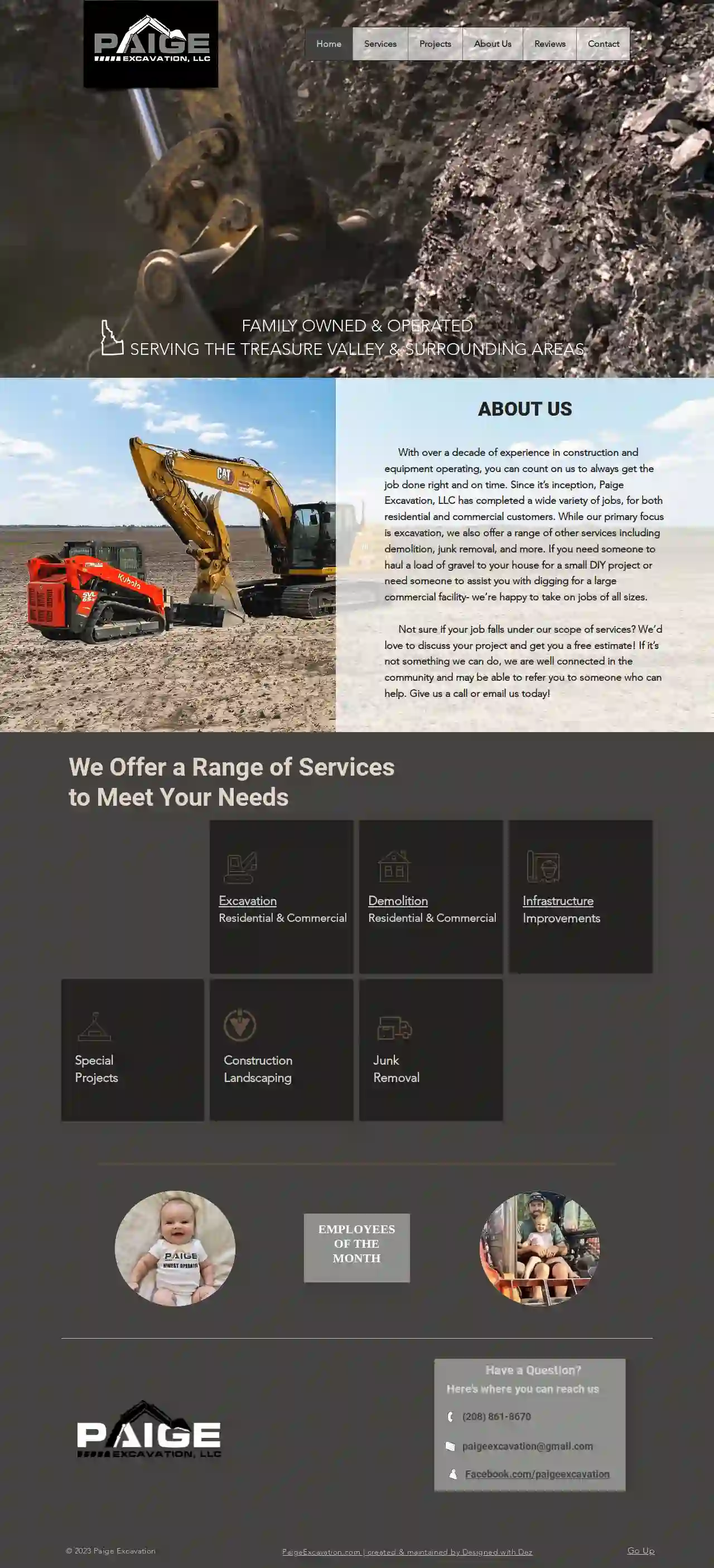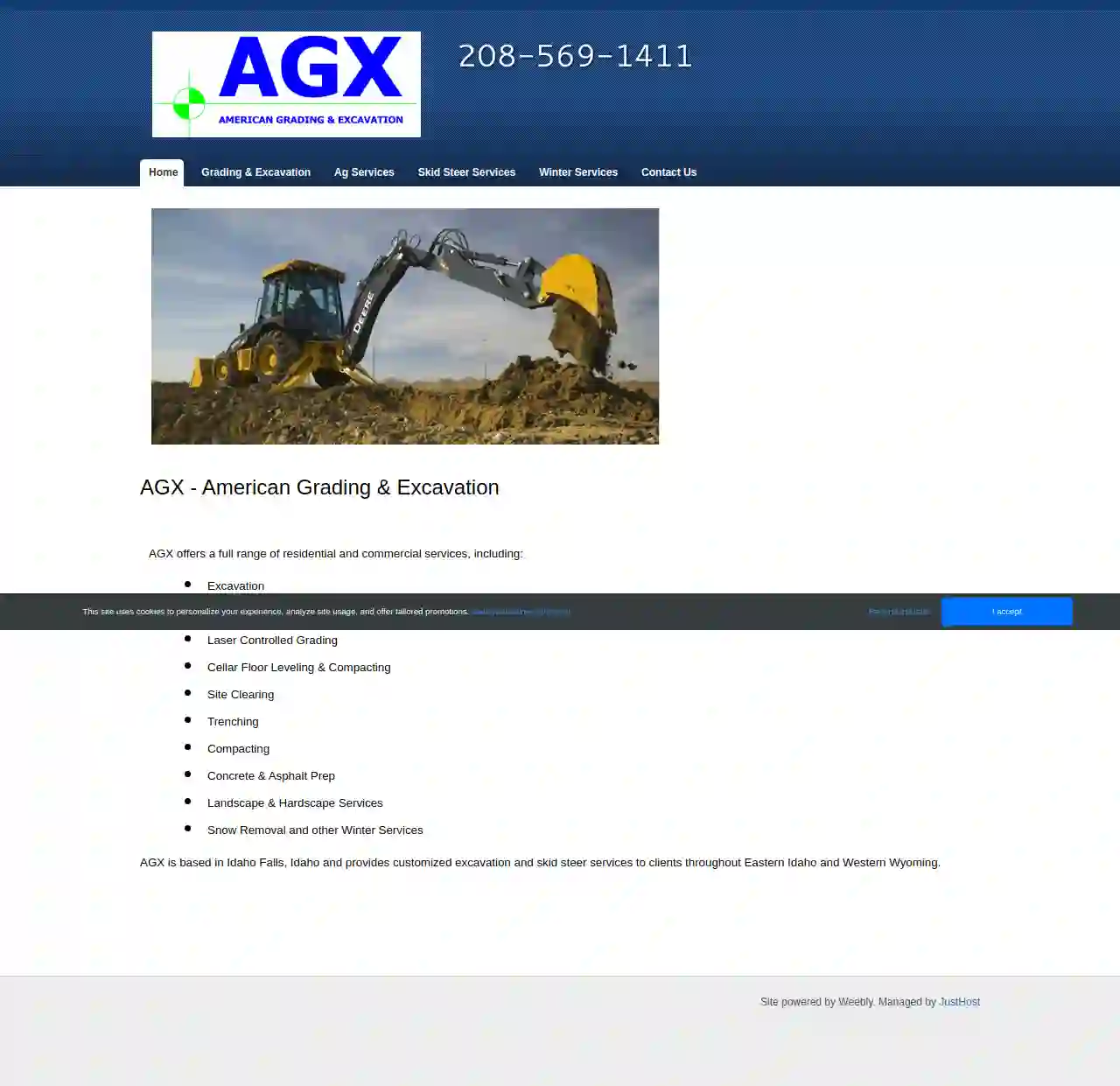Excavation Contractors Helena
Find Excavation Services in Helena
Receive 3 FREE Land Excavation quotes for your project today! Compare profiles, reviews, accreditations, portfolio, etc... and choose the best deal.

Creekside Excavation
57 reviewsSpokane, USAbout Creekside Excavation Creekside Excavation, a family-owned business founded by seasoned pros Mitchell Snyder and Colby Mead, combines over 15 years of local expertise in both residential and commercial excavation. Based in Spokane, WA, our commitment to exceptional customer service includes prompt responsiveness and same-day bids. Our extensive construction background drives our proficiency in excavation, septic systems, site prep, and custom projects. Trust us for transparent, consistent quotes that empower you to plan confidently and bring your projects to life. Why Creekside? Exceptional customer service is our commitment, ensuring your needs are our top priority with a dedicated and attentive team. Quality Customer Service Our expert excavation services offer precision and efficiency, ensuring seamless groundwork for construction projects of any scale. Expert Excavation Count on us for reliable solutions, delivering consistent and effective results for all your needs. Call us now to schedule your excavation services and take the first step towards a seamless and efficient construction or project experience.
- Services
- Why Us?
- Our Team
- Testimonials
- Gallery
Get Quote
Lish Excavation Co.
Spokane Valley, 99206, USAbout Lish Excavation Lish Excavation is a family-owned and operated business proudly serving Eastern Washington and North Idaho since 2007. We are dedicated to providing our customers with high-quality excavation services at affordable prices. We work closely with our customers to understand their needs and ensure they are satisfied with the final product. We believe in building strong relationships with our customers and local contractors. Over the years, we have developed partnerships with local businesses for most of the materials and services we use, which allows us to keep our costs low and pass those savings on to our customers. With our quality workmanship and affordable prices, Lish Excavation has quickly become one of the area's top providers of reliable excavating solutions. We are licensed in Washington and Idaho. Meet the Owner Bryce Lish is the owner of Lish Excavation. He has over 15 years of experience in the excavation industry and is committed to providing his customers with the best possible service. You can reach Bryce at (509) 216-0549 or [email protected].
- Services
- Why Us?
- Our Team
- Gallery
Get Quote
Spiers Construction
2.98 reviews1161 W River St, Boise, 83702, USUpHero is a local SEO, website, and Google Maps ranking service that helps businesses save money and make more money. We offer a variety of services to help businesses improve their online presence, including: Website design and development SEO optimization Google Maps ranking Paid advertising Social media marketing Content marketing Conversion optimization Business consulting We are a team of experienced marketing professionals who are passionate about helping businesses succeed. We offer a variety of packages to fit your budget and needs. We also offer a free website analysis to help you understand your current online presence and how we can help you improve it. We are committed to providing our clients with the highest quality services and results. We are confident that we can help you achieve your business goals. We are a local business, serving Boise and the surrounding areas. We understand the unique challenges that businesses face in our community. We are committed to providing our clients with the best possible service and support. We are a team of experienced marketing professionals who are passionate about helping businesses succeed. We offer a variety of packages to fit your budget and needs. We also offer a free website analysis to help you understand your current online presence and how we can help you improve it. We are committed to providing our clients with the highest quality services and results. We are confident that we can help you achieve your business goals. We are a local business, serving Boise and the surrounding areas. We understand the unique challenges that businesses face in our community. We are committed to providing our clients with the best possible service and support.
- Services
- Why Us?
- Our Team
- Testimonials
- Gallery
Get Quote
Paige Excavation, LLC
57 reviewsBoise, USFAMILY OWNED & OPERATED SERVING THE TREASURE VALLEY & SURROUNDING AREAS ABOUT US With over a decade of experience in construction and equipment operating, you can count on us to always get the job done right and on time. Since it’s inception, Paige Excavation, LLC has completed a wide variety of jobs, for both residential and commercial customers. While our primary focus is excavation, we also offer a range of other services including demolition, junk removal, and more. If you need someone to haul a load of gravel to your house for a small DIY project or need someone to assist you with digging for a large commercial facility- we’re happy to take on jobs of all sizes. Not sure if your job falls under our scope of services? We’d love to discuss your project and get you a free estimate! If it’s not something we can do, we are well connected in the community and may be able to refer you to someone who can help. Give us a call or email us today!
- Services
- Why Us?
- Gallery
Get Quote
Iron Horse Excavation
52 reviews875 W. Gowen Rd., Boise, 83705, USAbout Iron Horse Excavation Iron Horse Excavation is one of Idaho’s most trusted and successful excavation companies, specializing in earthwork, site development, utilities, grading, footing excavation, slab prep, septic systems and contract trucking and transport services. Iron Horse Excavation is a licensed contractor, bonded / insured and a proud member of the Better Business Bureau and the Idaho Association of General Contractors. Iron Horse Excavation is licensed in Idaho, Oregon and Washington. Dedication & Experience Iron Horse Excavation is an employee driven company that has the best equipment and manpower to handle any size of job. Owner, Mike Basabe’s extensive expertise in earth works and attention to detail ensures every project is completed on time and within budget. We are dedicated to the safe and timely production of work, giving personal attention and quality service to the contractor and project owner. Safety Iron Horse Excavation is committed to the safety of employees and projects on all levels. Safety meetings are held weekly, while each site follows through with safety inspections each morning. All key employees are “Responsible Person” trained as well as the OSHA Construction 10 Hour Occupational Safety. We encourage you to invest some time getting to know our company. We look forward to working with you.
- Services
- Why Us?
- Gallery
Get Quote
TNG Excavation
512 reviewsBoise, USWelcome to TNG Excavation - Excavating Contractor We are a proud family owned and operated company. With over 20 years in excavation, we strive for customer satisfaction from beginning to end. Your happiness is our guarantee! A Variety Of Services TNG Excavation offers many different services, letting you get a lot of the work done with just one company! Excavation Services Basic & Complex septic system Sewer- Water- Septic Foundation Grading & Leveling Site Prep- Prep Work French Drains Trenching-Utilities Driveways/Parking Lots/RV Pads Servicing Nampa, Caldwell, Boise, Meridian, Kuna, Emmett, Star, Eagle, Payette, Fruitland, Garden Valley, Valley County, Boise County, Elmore County, Treasure Valley. Have It Done Right We guarantee your satisfaction. With an average 5 Star rating, your experience with TNG Excavation is the most important to us! We are honest, reliable, and efficient; everything you've been looking for! We are fully licensed, insured, and bonded, including Public Works.
- Services
- Why Us?
- Gallery
Get Quote
Goodwin Dirt Works LLC
53 reviewsAirway Heights, USEFFICIENT. RELIABLE. EXCEPTIONAL. COMPETENCY. SAFETY. QUALITY. CUSTOMER SATISFACTION
- Services
- Why Us?
- Testimonials
- Gallery
Get Quote
Boise Excavating
52 reviews212 N. Flume Street, Boise, USExperienced Excavating Contractors in Boise, Idaho Your Trusted Excavation Partner for Transforming Landscapes in the Treasure Valley Get Your Free Estimate 208-510-0288 Boise Excavating is your premier excavating contractor serving Boise, Idaho, and surrounding communities. With an unwavering commitment to precision and a passion for excellence, we are proud to be your trusted excavation partner in the Treasure Valley. We offer a comprehensive range of excavation services to cater to your diverse needs. Whether you require: Pre-Construction & Site Prep General Earthwork Pool & Pond Installations Basement & Crawlspace Dig Outs Trenching Demolition Work Lot & Land Clearing Post-Construction Services Our team of skilled experts is equipped to handle any project with utmost proficiency, and we are easy and friendly to work with. To get started, call us at 208-510-0288 or submit your request on our form. Expert Excavation Services: Outstanding Results Our excavation masters are not just skilled operators but artists who transform landscapes into functional and visually captivating spaces. We take pride in enhancing the value of your properties and ensuring your complete satisfaction with every endeavor we undertake. As a customer-focused excavation business, we prioritize open communication and transparency throughout the entire process. No matter the complexity or scale of your project, we take the time to understand your unique requirements and work collaboratively to deliver results that surpass expectations. For us, safety, compliance, and environmental responsibility are paramount. We adhere strictly to industry standards and regulations, ensuring a seamless and secure excavation process on your property. Whether you’re a property owner, builder, or business owner, our expertise in excavation can fulfill your needs. From precise pre-construction site preparation to exquisite pool and pond installations, we’ve got you covered. With a wealth of experience in excavation, our team consistently delivers outstanding results. We take pride in our expertise, which allows us to handle a wide range of excavation projects with precision and efficiency. From digging foundations and trenches to clearing land for construction, we ensure every task is executed to the highest standards. Our commitment to excellence is evident in the quality of our work. Our skilled operators and advanced equipment enable us to tackle even the most challenging excavation jobs, producing exceptional results every time. Whether it’s for residential, commercial, or industrial purposes, our experienced team has the knowledge and skills to get the job done right. When you choose us for your excavation needs, you can trust that we prioritize safety, environmental responsibility, and client satisfaction. With our experienced excavation services, you can rest assured that your project will be in capable hands, and the end result will exceed your expectations. Excavation Services: Serving Boise and the Treasure Valley Our excavation services cater to the needs of Boise and the entire Treasure Valley region. With a strong presence in the area, we have developed a reputation for providing reliable and top-notch excavation solutions. Whether it’s residential, commercial, or industrial projects, we offer a comprehensive range of services to meet diverse requirements. Our team of experienced professionals is well-versed in the unique challenges presented by the local terrain and weather conditions. We are committed to providing our clients with the highest quality excavation services, ensuring their projects are completed on time and within budget.
- Services
- Why Us?
- Gallery
Get Quote
Tony Young Underhouse Excavation - Basements Under Existing Houses
Boise, USExperience and knowledge | honesty and integrity | customer satisfaction Over 40 years Experience in basement excavation A basement is the most economical way to add square footage to your home. It is very energy efficient. The process normally take about a month and you are able to continue living in your home. Digging basements under existing homes from start to finish. We also repair foundations and old basements. We do additions and remodels. Add square footage to your home Double your square footage by building a new home UNDER your existing one. No need to move or get inconvenienced…we create a whole new space for you from start to finish within a month’s time. With over 30 years of basement-building experience in the Treasure Valley, we’ve dug under hundreds of homes carefully and professionally, giving them basements that stay cool in the summer and warm in the winter. Call 208-870-7713 today and let us give you a whole new home. Quality craftsmanship Our Business Focus is Customer Satisfaction, Making the customer happy, environmental friendly, the basements we build takes very little energy to heat or cool, Love your location but need more space? We can do that for you. How about nearly twice the square footage you’ve got now…just imagine. We’ll put a basement under your home in about 30 days’ time, while you’re still living there Licensed Contractor for the following services: Excavating Contractors Construction & Remodeling Services Basement – Contractors Remodeling Services Foundation Repair Additions & Add-ons
- Services
- Why Us?
- Gallery
Get Quote
AGX-American Grading & Excavation
PO Box 2926, Idaho Falls, 83403, USAGX - American Grading & Excavation AGX offers a full range of residential and commercial services, including: Excavation Skid Steer Services Laser Controlled Grading Cellar Floor Leveling & Compacting Site Clearing Trenching Compacting Concrete & Asphalt Prep Landscape & Hardscape Services Snow Removal and other Winter Services AGX is based in Idaho Falls, Idaho and provides customized excavation and skid steer services to clients throughout Eastern Idaho and Western Wyoming.
- Services
- Why Us?
- Gallery
Get Quote
Over 22,076+ Excavation Companies on our platform
Our excavation contractors operate in Helena & beyond!
ExcavationHQ has curated and vetted Top Excavation Businesses in Helena. Find the most trustworthy business today.
Frequently Asked Questions About Excavation Contractors
- Project Size and Scope: Larger, more complex excavations naturally take longer.
- Soil Conditions: Rocky or challenging soil types can slow down progress.
- Site Accessibility: Limited access might require more time for maneuvering equipment and hauling materials.
- Weather: Inclement weather can cause delays.
- Permitting and Inspections: Waiting for permits or inspections can extend the timeline.
- Soil Type and Stability: Stable, cohesive soils allow for deeper excavations than loose or unstable soils.
- Groundwater Level: Excavations below the water table require dewatering techniques to manage water intrusion.
- Equipment and Resources: The size and capabilities of excavation equipment influence the achievable depth.
- Safety Regulations: OSHA and other safety regulations impose limitations on trench depths without proper shoring or sloping.
- Project Requirements: The purpose of the excavation (basement, pool, foundation) determines the necessary depth.
- Sloped Property: Your property has a significant slope, making it prone to soil erosion or landslides.
- Creating Usable Space: You want to level off a sloped area to create a flat surface for patios, gardens, or other outdoor spaces.
- Preventing Damage: Erosion is threatening existing structures, driveways, or walkways.
- Landscaping Features: You're incorporating tiered gardens, raised beds, or other landscaping elements requiring soil retention.
- Mechanical Excavation: Utilizing heavy equipment like excavators, backhoes, bulldozers, and loaders, suitable for most projects.
- Hand Excavation: Using hand tools (shovels, picks) for smaller excavations or delicate work near utilities.
- Blasting: Employing explosives to break up rock or hard materials, typically for large-scale projects.
- Hydro Excavation: Using high-pressure water jets to loosen and remove soil, often used for locating utilities or delicate excavation.
- Vacuum Excavation: Employing a vacuum system to suck up excavated material, suitable for safe excavation near utilities or in confined spaces.
How long does an excavation project take?
How deep can you excavate?
How do I know if I need a retaining wall?
What are the different methods of excavation?
How long does an excavation project take?
- Project Size and Scope: Larger, more complex excavations naturally take longer.
- Soil Conditions: Rocky or challenging soil types can slow down progress.
- Site Accessibility: Limited access might require more time for maneuvering equipment and hauling materials.
- Weather: Inclement weather can cause delays.
- Permitting and Inspections: Waiting for permits or inspections can extend the timeline.
How deep can you excavate?
- Soil Type and Stability: Stable, cohesive soils allow for deeper excavations than loose or unstable soils.
- Groundwater Level: Excavations below the water table require dewatering techniques to manage water intrusion.
- Equipment and Resources: The size and capabilities of excavation equipment influence the achievable depth.
- Safety Regulations: OSHA and other safety regulations impose limitations on trench depths without proper shoring or sloping.
- Project Requirements: The purpose of the excavation (basement, pool, foundation) determines the necessary depth.
How do I know if I need a retaining wall?
- Sloped Property: Your property has a significant slope, making it prone to soil erosion or landslides.
- Creating Usable Space: You want to level off a sloped area to create a flat surface for patios, gardens, or other outdoor spaces.
- Preventing Damage: Erosion is threatening existing structures, driveways, or walkways.
- Landscaping Features: You're incorporating tiered gardens, raised beds, or other landscaping elements requiring soil retention.
What are the different methods of excavation?
- Mechanical Excavation: Utilizing heavy equipment like excavators, backhoes, bulldozers, and loaders, suitable for most projects.
- Hand Excavation: Using hand tools (shovels, picks) for smaller excavations or delicate work near utilities.
- Blasting: Employing explosives to break up rock or hard materials, typically for large-scale projects.
- Hydro Excavation: Using high-pressure water jets to loosen and remove soil, often used for locating utilities or delicate excavation.
- Vacuum Excavation: Employing a vacuum system to suck up excavated material, suitable for safe excavation near utilities or in confined spaces.